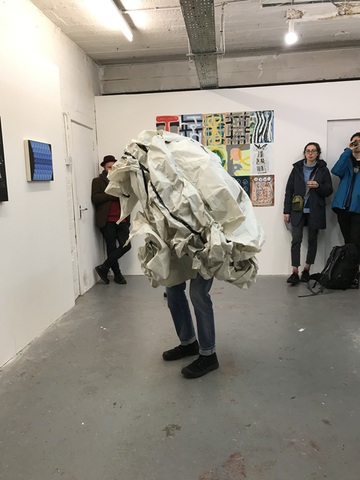Drawing the invisible in plain sight
Burgoyne, Greig (2022) Drawing the invisible in plain sight. In: drawing conversations #4, 2 September 2022, University of Huddersfield.
- Images
- Documents
- Details
This is a presentation about Pier dig. This is a durational drawing performance that took place on Portobello beach, Edinburgh, and was commissioned for the Arts Festival ArtwalkPorty.
The performance lasted 7 ¾ hours. It began with Burgoyne marking out an area of beach, relative to its original size 128 mtrs x 23 mtrs of a pier which once stood there, prior to it being washed away in a storm in the early part of the 1930’s.
This presentation seeks to propose that drawing in its engagement and immersion with a site may be one in where the memory of the place and the memories to come following that engagement oscillates akin to an event of perpetual forming and unforming.
To unpack this work, is to acknowledge drawing as a phenomenological field uniting site, memory and gesture. Further, drawing is an act of withdrawal, not application of mark, in this case between spade and sand. In the words of Jean-Lucy Nancy ‘drawing its mark from this withdrawing- The place that is estranged from all forms.’
To support this Burgoyne will explore key contexts including places being of elements and not productions of ‘things’ (Merleau-Ponty/Levinas), the concept of clearing as a means in which materials in this case energy and sand are absorbed in the making of the work ( the drawing), as it discloses an ontology of site beyond the exteriority and aesthetic appearance (Heidegger). In doing so, an intersubjectivity may emerge where upon as Merleau-Ponty states ‘the visible is pregnant with the invisible’ and in contrast to the functionality of material (Heidegger) memory makes the past available to me for my future (Levinas).
In referencing these contexts, pier dig will align the knowledge we bring to a site, and the experience of that site as one in which we co-create a pre-reflective situation as we immerse in the rich transformation and apprehension of drawings’ as a site of raw facticity. In this way indicative of what Levinas refers to as ‘the living contradiction’(2015:142). This is to say we strive in our actions as -in drawing upon a site between two trajectories. One that is casual and operates in past, present, future mode, and the other being pre-reflective which is ahead of itself as an intention. As such in reverse i.e. Aligned to future, as such followed by present, then past.
Within this phenomenon of contraction and expansion, the performance began at low tide, and sees Burgoyne enter a subsequent battle to maintain the space drawn out, by moving the ‘pier’ up the beach to prevent the site from impending erasure. Both absurd and tragic, as he attempts to maintain the site within site, the ongoing relocating of the ‘pier’ ultimately concludes with Burgoyne unable to distinguish the sand /site he is moving, from the sand and locality it is upon.
This paper proposes to suggest the pier being drawn is ultimately concealed in plain sight and as such to draw ‘place’ is to evolve an interspace between past and future that is present through its dispersal, indeed as Levinas suggests this ‘non representability is the surplus of the lived body over the representation of it.’ (2015:43)
This presentation will aim to unpack the paradoxical nature of drawings rapport with site and memory. In this, actions and strategies of erasure are in fact the means to reveal the concealment inherent within the site as one set of assemblage unforms and another is open and fluid in that reterritorialization and forming. This will be to suggest that the unity of labour and freedom as conceptual frameworks are symptomatic of labour in which we make futures. In this way we establish home. But what kind of home is this? if indeed it is an autonomy that is ungraspable.
This is to say, drawing is less an advancement into space but could well be a repetitive act of incessant withdrawal and removal, through that intertwining of vision and movement. As such that which is removed, the marks left is a site in itself, indicative of locating, that oscillates between the elemental, sensorial event and the thing it may be seeking to preserve that is in the process of been relocated.
In this way Pier dig is symptomatic of that being- in- its- self, between place and experience, akin to a habitation if temporal, akin to a duality of forming and unforming manifestation of memory. A visualisation of invisibility where proximity and physicality of distance is reversed, whereby what was at hand is now dispersed, while that drawings’ dasein is now ever closer.
In conclusion Pier dig will aim to emphasise drawings rapport with history and site, as ultimately a dragging and pushing of space and matter in a convergence between 2 points. Displacement of the memory origination of a site, and the extending of that spatiality through drawing toward alternate horizons and destinies that are uncontainable: ‘Drawing wants to show the truth, not what has appeared or its appearance, but of the coming into appearance… this is about showing what does not show itself. (2003:92)
In this it is paradoxical, where rules and process lead less to a greater unity of site and its history through drawing, but as shifting plates of sedimentation, revealing less their unity but indicative of the potential of separation instead.
Actions (login required)
 |
Edit View |
